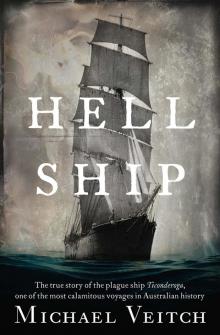- Home
- Michael Veitch
Hell Ship
Hell Ship Read online
Also by Michael Veitch
Barney Greatrex
44 Days: 75 Squadron and the fight for Australia
Heroes of the Skies
Southern Surveyor
The Forgotten Islands
Fly
Flak
First published in 2018
Copyright © Michael Veitch 2018
All rights reserved. No part of this book may be reproduced or transmitted in any form or by any means, electronic or mechanical, including photocopying, recording or by any information storage and retrieval system, without prior permission in writing from the publisher. The Australian Copyright Act 1968 (the Act) allows a maximum of one chapter or 10 per cent of this book, whichever is the greater, to be photocopied by any educational institution for its educational purposes provided that the educational institution (or body that administers it) has given a remuneration notice to the Copyright Agency (Australia) under the Act.
Allen & Unwin
83 Alexander Street
Crows Nest NSW 2065
Australia
Phone: (61 2) 8425 0100
Email: [email protected]
Web: www.allenandunwin.com
ISBN 978 1 76063 084 3
eISBN 978 1 76063 664 7
Internal design by Midland Typesetters, Australia
Set by Midland Typesetters, Australia
Cover design: Deborah Parry Graphics
Cover photo: Australian National Maritime Museum, bow view of three-masted training ship Mersey, Shutterstock
To the boat people from every land and every era.
Contents
Prologue
1 A lonely beach
2 Birkenhead
3 Wakefield and ‘the Board’
4 Australia 1851: Gold versus wool
5 The Scots
6 The age of the clippers
7 The Ticonderoga
8 Emigrants and numbers
9 Departure
10 Clearances and famine: The tragedy of the Highlands
11 Life at sea
12 Death at sea
13 A lonely encounter
14 The Great Circle
15 Surgeons at sea
16 The first cases
17 Typhus takes hold
18 The box with the dull pink ribbon
19 The Southern Ocean
20 Hell Ship
21 Arrival
22 Protecting the colony
23 A colonial crisis
24 The Lysander
25 Quarantine and outrage
26 A Christmas escape
27 A visit from the Governor
28 The last journey
29 The Maitland
30 Life goes on
31 The aftermath
Epilogue
Acknowledgements
A note on sources
Notes
Bibliography
Prologue
There is only one known image of my great-great-grandfather, Dr James William Henry Veitch. It is a classic Victorian-era portrait, taken in a Melbourne photographic studio sometime—we believe—in the late 1880s. A large man, he stands confidently in front of a canvas backdrop painted to resemble the fashionable drawing room of a home of the well-to-do. His left elbow rests against the back of a turned wooden chair, which one suspects is a little too low for comfort. Beside him, seated on a chaise longue and affecting a similar air of repose, is his wife of many years, my great-great-grandmother, Annie. She, by contrast, is small and delicate—almost bird-like.
The two had met over 30 years earlier on the ship that had brought them to Australia from England at the height of the gold rush. Annie Morrison, travelling as a single, educated assisted female emigrant, had expectations of obtaining a position such as a governess with a prosperous colonial family; James, descending from a long line of naval surgeons, and having recently secured his first contract as assistant surgeon on board a government-commissioned emigrant vessel, anticipated the beginning of a long and prestigious career at sea. Instead, what awaited them on the voyage would change and haunt them for the rest of their lives.
On an uncharacteristically sultry Liverpool day in August 1852, both of them—still in their twenties and as yet unknown to each other—had made their way up the steep timber gangway of the great black-sided ship before turning for a final glimpse of the home they were leaving behind. Only one of them, however, knew it was forever.
* * * *
Like the fragile and feverish ghosts of those who perished within the wooden tomb of the ship, their story has lingered in my family for generations. Only in his later decades could my own father bring himself to utter that strange-sounding name in anything more than a whisper: Ticonderoga. It was as if what had been seen all those years ago by the grand old man—the revered doctor, the hero ancestor, the first and most noble of our clan to bring our old Scots name to this part of the world—was too terrible to be contained within a single individual, or even a single generation.
I study Annie’s face in the photograph. In it, I see those familiar, fine-boned, pleasant features that have graced many of the women in my family. I imagine her voice soft with the burr of her native Argyllshire—she came from Tobermory on the Isle of Mull in the Western Isles of Scotland. Her dark-eyed gaze, like her husband’s, is fixed on a point a little to their right, where the man behind the camera has directed them to concentrate their attention—quite immobile—until the exposure is complete. Well over a century later, I am immensely grateful for that unknown photographer’s diligence, as there is something rather magnificent about his portrait of Dr James William Henry and Annie Veitch.
They are both dressed in their finest clothes: Annie in the formal black of a respectable Victorian lady, James wearing his woollen country gentleman’s garments with ease, his right hand thrust jauntily into a front trouser pocket. His small pair of steel-rimmed spectacles appear dwarfed by his large face, which is itself framed by a ring of white whiskers, despite his head being quite bald. His cheeks and chin are shaved smooth, revealing a fine and clear complexion (the Veitch men have always been blessed with good skin). His frame is solid but not fat, the mouth set straight and outwardly expressionless, but as I look I cannot help but detect the slightest hint of a smile.
It is his eyes, however, that intrigue me most. His gaze is strong and deliberate, but also welcoming. I am convinced—family bias aside—that I can see in that steady face a man upon whom countless others had long come to rely. Years earlier, in their desperate and dying hours, many of the wretched passengers on board his ship may well have arrived at the same conclusion about the kind and tireless Dr Veitch, and the devotion he showed to them during the single, calamitous voyage to Australia of the vessel they dubbed the ‘floating charnel house’, the ‘plague ship’, the ‘Hell Ship’: the Ticonderoga.
She was a clipper—said to be one of the most magnificent afloat. While still in port in Birkenhead, crowds from nearby Liverpool would flock across the Mersey to gaze at this four-masted beauty with her exotic name: American built, fine-lined like a thoroughbred and over a thousand tons. Her twin decks, they were told, would accommodate nearly 800 souls. Imagine that!
They would be mainly Scots, cleared ruthlessly from their ancestral homes in the Highlands, then subjected to famine and in terrible straits: many were crofters, exiled to the edges of their landlords’ estates, struggling to feed their families from tiny, unsustainable patches of soil, desperate for a better life on the other side of the world. Many of them spoke no English, others from the small villages in the glens had not so much as laid eyes upon the ocean in their entire lives. They stood by the dock, gaping at its vast expanse in wonder.
As a child, I had been told the story by my father,
who in turn had been told by his, who would have heard it from Henry Veitch, the youngest son of James William Henry himself. Looking back, I seem to have come to it slowly, in fragments, and I suspect my father was disappointed in my response to this, our family’s single truly dramatic chapter.
In fact, the story of the Ticonderoga affected me deeply. One image in particular lodged itself early in my brain and has remained with me all these years. It is that of the ship’s lower deck—or rather the entrance to it. As a child, I would envisage that black hatchway plunging away from the sunlight into the dark and polluted chamber of death below. Here, in their hundreds, the passengers—men, women, infants—lay writhing in the agony and delirium of the typhus epidemic that had exploded in the dank and overcrowded bowels of the vessel, tearing through their ranks, killing over a hundred in just a few weeks and pitching many more into an illness so desperate that they would never fully recover from it. At first the dead had been buried with proper decorum at sea; however, as their numbers doubled and then trebled, they were simply hurled overboard—like ‘stiff-legged rag dolls’ as one passenger would remember it—as horrified family members looked on in shock.
As awful as this was for me, as a child, to contemplate, there was one particular detail of the passengers’ suffering I was mercifully spared: the stench. Typhus, I learned later, is a particularly grim disease. Besides the racking flu-like cough and agonising muscle spasms, the scarlet rash, the delirium and the deadly burning fever, it also savages its victims with a stink—supposedly resembling rotting flesh—so rancid that the smell of a single typhus patient can be overwhelming, even today behind the closed door of a hospital ward.
I saw (indeed, I can still see) that yawning black hole—the closest thing my young imagination could conceive to a vision of hell—opening wide to grab me, to engulf me, to suck me down into its unspeakable horror.
When, after 90 days at sea, the Ticonderoga limped to her destination and entered the heads of Port Phillip Bay, it is little wonder that those who observed her uttered the words ‘ghost ship’. Upon inspection by the authorities, her condition caused deep shock even in those hard colonial men, long inured to the dismal standards of nineteenth-century medicine. It was a fact of life at sea that people died—particularly on the long journey from Britain to Australia—but nobody had ever seen anything like what had occurred on board the Ticonderoga.
When news of her arrival spread, she was forbidden to travel up the bay to Melbourne, and instead ordered to disgorge her wasted human cargo onto an isolated beach. The site became a makeshift quarantine station that then evolved into an institution lasting more than a century.
On this lonely shore, Dr Veitch shouldered a double burden since the ship’s senior surgeon, Dr Sanger, had himself succumbed to the disease. For more than six weeks, Dr Veitch continued to oversee those in quarantine, assisted now by a handful of the passengers, particularly a quiet, striking Highland woman to whom fatigue meant nothing, and who had been one of the first to respond, without question, to his urgent pleas for help. Even here, on the beach, many would continue to die.
After the last of the funerals, and the inquiry that sought to ensure nothing like this disaster would ever occur again, Veitch took his dark-eyed Annie far from the sea, settling with her in central Victoria, where he lived his years as a quiet country doctor and local councillor, never setting foot on a ship again.
Although I never gave my father any indication of just how strongly I was affected by the tale, the time has come for me to take up the mantle of my family’s saga, and recount the doomed journey of the Ticonderoga and the poor souls she carried. It is, of course, more than the story of just one man, or just one family. Hundreds survived the voyage and went on to establish themselves as the first in long lines of Australian families that prosper to this day. On this island continent, we are all of us, save for those who walked here millennia ago, boat people. This is the story of how some of us arrived, aboard the doomed Ticonderoga.
My father died more than a decade ago. Were he still alive, though, I would ask him—along with many other things—whether he felt his connection to the Ticonderoga saga was a privilege or a burden. I suspect he would answer, ‘Both’. I am yet to form my own conclusion.
1
A lonely beach
Brothers-in-law William Cannon and Patrick Sullivan squinted to the sun, not quite yet at its midday peak, resting for a moment on their shovels. Their trade of lime-burning was hot work, made more so by this warm November morning. In front of them, across a few hundred yards of coarse, white sand dunes, stretched a narrow ribbon of beach. Beyond that lay the sparkling expanse of Port Phillip Bay. If both men were to have strolled the short distance to the beach, then set off in opposite directions, one of them would have had only a short journey to the west before reaching the mouth of the bay at Point Nepean, where the narrow gap—known simply as the Heads—opens to the treacherous and unpredictable waters of Bass Strait. The other man, heading east and following the great sweep of the bay’s shoreline as it turned north, would have faced a trek of several arduous days through eucalypt and ti-tree scrub to the top of the bay before reaching the bustling settlement of Port Phillip and the town of Melbourne, now in the grip of gold fever. He could then, if he chose, have continued along the shoreline to the south-west, passing the smaller port settlement of William’s Town—as it was then known—before eventually arriving, not quite full circle, at Point Lonsdale, the opposite jaw of the mouth of this large and almost landlocked bay.
The lime-burning and fishing leases that Sullivan and Cannon, along with a number of other pioneering families, had acquired for their lonely stretch of beach made for a sparse, though not unprofitable, life. The expanding city hungrily devoured every ounce of the quicklime their kilns could produce from the piles of aeons-old sea creatures around them, providing the mortar for the bricks, streets and lanes of Melbourne. Sullivan had even put down some roots, constructing a tidy whitewashed three-bedroom cottage using local stone and wattle and daub walls. Outside, a small well had been sunk, providing passably fresh water struck just a few feet beneath the sandy surface. Large expanses of gnarled ancient ti-trees provided the dense, heavy fuel required to heat the lime kilns as well as the men’s winter hearths. In the several years these two men and others had worked their leases, not much had changed along their peaceful stretch of beach, and this November morning they had no reason to suspect that their idyllic little world would soon to be consumed by catastrophe.
In the middle of their regular mid-morning break, the men lit a pipe and spoke quietly about the afternoon’s work. Suddenly, Sullivan’s face darkened as something across the water drew his gaze. ‘Look there,’ he said, his voice low and ominous. His companion looked up, and both men fell into silence as they observed a magnificent black sailing ship apparently heading straight for them.
For Sullivan and Cannon, the sight of passing ships further out on the bay was nothing new. In July 1851, Victoria had finally been carved out of New South Wales and proclaimed a partially self-governing Crown colony, with a promise that it would become a full colony in its own right in five years’ time. Then, barely a month later, the electrifying announcement came: gold—apparently in unbelievable quantities—had been found at Clunes near the inland settlement of Ballarat. From that moment, it seemed to Sullivan and Cannon, the steady trickle of ships became a torrent.
In March 1851, for example, the records show just a handful of major ships dropping anchor in Melbourne: the Dockenhuden, Harriette Nathan, Ranchi and Favourite—schooners and barques bringing a few hundred passengers, mainly from other Australian ports. A year later, after the shockwave of gold had begun to reverberate, Port Phillip recorded no less than 43 arrivals, almost all of them emigrant vessels of all sizes and from all parts of the world. There was the 450-ton Celia from Gothenburg, the barque Wilhelmine from Batavia, the 851-ton Lady Elgin from Plymouth, and the 257-ton George from Singapore. Everyone, it seemed,
suddenly wanted to come to Victoria.
The previous September, they had even watched the arrival of the gigantic clipper Marco Polo, which astonished the world by powering past the Heads a mere 68 days after departing Liverpool, with her master, the famous Captain James Nicol ‘Bully’ Forbes, proudly standing on the forecastle, brandishing a copy of an English newspaper kept in pristine condition from the morning of his departure, 4 July 1852. Across the route known as the ‘Great Circle’, through the fiercest of Southern Ocean storms, Forbes had ridden his ship like a wild beast, close to the edge of Antarctica as well as his terrified passengers’ wits. At the height of one such gale, his vessel tearing along at a demented speed, one passenger braved the pitching deck to approach Forbes as he stood beside the wheel, apparently mesmerised by the demonic elements swirling around him. For the sake of his own and the other passengers’ comfort, he begged the Captain to consider reefing some sail and slowing down a little. The captain’s reply, ‘Sir, I’m afraid it is a case of Hell or Melbourne’1 passed quickly into maritime folklore. Averaging a daily total of 336 nautical miles, ‘Bully’ Forbes’ record would stand for years.
As impressive as the Marco Polo and many other vessels had been, though, neither Sullivan nor Cannon had seen anything quite like the great, black, deathly quiet ship that was now approaching from the far side of the bay and preparing to hove-to just a few hundred yards off their peaceful beach. She was, they could tell, an emigrant vessel—and a big one. Not quite as large as the Marco Polo, but with finer lines; her darkly painted hull still fresh despite a long sea voyage; four masts, and the distinctive steep-raked, slicing bow of the American-built clippers. A beautiful ship indeed, noted her two lonely observers, but something about her was not right. Where on earth were her passengers? Particularly on such a fine day as this, the exhaustion and anxiety of months spent crammed into a few square feet of dank space below deck alongside hundreds of others would normally finally give way to joyous relief and celebration. Only now, gliding up this calm and generous bay, having survived the endless uncertainties and warded off the haunting visions of rocks splitting open wooden walls with seas rushing in to rip loved ones from outstretched arms, could a future at last be contemplated. Those who had trunks had them brought up from the lower holds to the upper deck, where they would select their finest outfit for their arrival. The ladies in particular would look splendid, adorning the ship like exotic birds with their red and green satins to mark their arrival at the dawn of a new life. But this ship, as the men remarked, was ‘like a ghost ship’: silent.

 Turning Point
Turning Point Heroes of the Skies
Heroes of the Skies The Forgotten Islands
The Forgotten Islands Hell Ship
Hell Ship Flak
Flak Fly
Fly